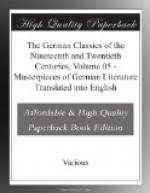and may be seen, touched, and heard. The creative
artist creates like nature in realizing the ideal;
hence, art must serve as the absolute model for the
intuition of the world—it is the true and
eternal organ of philosophy. Like the artistic
genius, the philosopher must have the faculty for
perceiving the harmony and identity in the universe;
esthetic intuition is absolute knowing. Art aims
to reveal to us the profoundest meaning of the world,
which is the union of form and matter, of the ideal
and the real; in art alone the striving of nature
for harmony and identity is realized; the beautiful
is the infinite represented and made perceivable in
finite form; here mind and nature interpenetrate.
In creative art the artist imitates the creative act
of nature and becomes conscious of it; in esthetic
intuition, or the perception of beauty, the philosophical
genius discovers the secret of reality; nature herself
is a poem and her secret is revealed in art.
This philosophy is a far cry from the logical-mathematical
method of the
Aufklaerung; it is a protest
against this, a protest in which the leaders of the
new German literature, Herder, Goethe, Schiller, as
well as the Romanticists, willingly joined. Goethe’s
entire view of nature, art, and life rested upon the
teleological or organic conception; he, too, regarded
the ability to peer into the heart of things—to
see the whole in its parts, the ideal in the real,
the universal in the particular, as the poet’s
and thinker’s highest gift. He called it
an
apercu, “a revelation springing up
in the inner man that gives him a hint of his likeness
to God.” It is this gift which Faust craves
and Mephisto sneers at as
die hohe Intuition.
Dass ich erkenne was die Welt
Im innersten zusammenhaelt,
Schau alle Wirkungskraft and Samen
Und tu’ nicht mehr in Worten kramen.
There was much that was fantastic in the Naturphilosophie
and much a priori interpretation of nature
that tended to withdraw the mind from the actualities
of existence; it often dealt with bold assertions,
analogies, and figures of speech, rather than with
facts and proofs. But it had its merits; for
it aroused an interest in nature and nature-study,
it kept alive the philosophical interest in
the outer world, the desire for unity, Einheitstrieb,
which has remained a marked characteristic of German
science from Alexander von Humboldt down to Robert
Mayer, Helmholtz, Naegeli, Haeckel, Ostwald, Hertz,
and Driesch. It opposed the one-sided mechanical
method of science, and emphasized conceptions (the
idea of development, the notion of the dynamic character
of reality, pan-psychism, and vitalism) which are
still moving the minds of men today, as is evidenced
by the popularity of Henri Bergson, who, with our own
William James, leads the contemporary school of philosophical
Romanticists.




